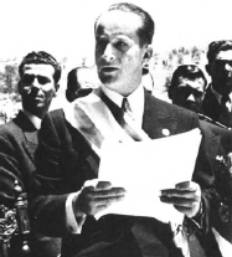 |
Jacobo Arbenz Guzman, the democratically-elected President of Guatemala, at his inauguration (1950).
|
1954, Guatemala: "Operation PBSuccess," Another Coup
By Kate Doyle, Director, Guatemala Documentation Project, National Security Archives
Most historians now agree that the CIA-sponsored military coup in 1954 was the poison arrow that pierced the heart of Guatemala's young democracy. Code-named "PBSUCCESS," the covert operation overthrew Jacobo Arbenz Guzman, the second legally elected president in Guatemalan history.
Over the next four decades, a succession of military rulers waged counter-insurgency warfare that shredded the fabric of Guatemalan society. The violence caused the deaths and disappearances of between 140,000 and 250,000 Guatemalans.
In 1997, the CIA released 1,400 pages of secret files on their first covert operation in Latin America. Citizens can now examine all the gory details: assassination plots, paramilitary and economic warfare, provocation techniques, psychological operations, rumor campaigns and sabotage.
Arbenz tried to change the country's rigid oligarchy. To the U.S., he was a danger of international dimensions: he permitted the Guatemalan Communist Party to operate openly and his land reform program threatened U.S. companies, like the powerful United Fruit Co.
By 1952, the CIA was recruiting forces to overthrow him. The CIA's "General Plan of Action" (1953) saw the military as "the only organized element in Guatemala capable of rapidly and decisively altering the political situation."
Proposals to assassinate leading members of the Arbenz government and his military supporters permeated the planning. The CIA's "Study of Assassination" is a 19-page manual detailing the procedures and instruments of assassination. "The simplest tools are often the most efficient.... A hammer, axe, wrench, screw driver, fire poker, kitchen knife, lamp stand or anything hard, heavy and handy will suffice." The study described assassination methods: "manual," "accidents," "drugs," "edge weapons," "blunt weapons" and "firearms."
The CIA's Directorate of Operations compiled hit lists of "top flight communists." One of many CIA assassination lists was "Selection of individuals for disposal by Junta Group," (Mar.31, 1954). The CIA requested names of government leaders, Communist Party members and individuals "of tactical importance whose removal for psychological, organizational or other reasons is mandatory for the success of military action."
CIA assassination plans included budgeting, training, creating hit teams, drafting target lists and transferring arms. The hit lists were purged of all names, making it impossible to check on the fate of proposed victims ("CIA and Guatemala Assassination Proposals," 1952-1954).
Covert CIA tactics included:
Provocation: A top secret memo (June 1, 1954), proposed using "simulated Guatemalan aggression against Honduras," faked kidnappings of prominent citizens and the desecration of churches with pro-communist slogans.
Psychological War: Frightened government officials and police with death notices, anonymous phone calls ("between 2 and 5 a.m."), spreading rumors and by mailing symbols (a coffin or a hangman's noose) to their homes.
Propaganda: Employed anti-communist students to create an impression of powerful opposition. Students leaf-leted public gatherings, wrote anti-government graffiti and distributed phony news articles written by the CIA.
In June 1954, having lost the army's support, Arbenz stepped down. In Washington, there was jubilation. This coup became the model for future CIA actions in Latin America. According to the CIA's historical account, the meticulous CIA coup-plotters had "no plans for what would happen next." They saw democracy as an "unrealistic" alternative and foresaw the best alternative as a moderate authoritarian, staunchly pro-American regime. Guatemala's political center quickly "vanished...into a terrorized silence."
When a small insurgency developed, Guatemala's military used U.S. military training, weapons and money to unleash a savage wave of repression that left thousands of peasants dead. The killing still continues.
Source: "Guatemala 1954: Behind the CIA's Coup," 1997.
www.consortiumnews.com/archive/story38.html
For more details, see declassified documents at www.gwu.edu/~nsarchiv/NSAEBB/index.html
"As a CIA operative, I trained Guatemalan exiles in Honduras to invade their own country and unseat the elected president.... The coup I helped engineer in 1954 inaugurated an unprecedented era of intransigent military rule in Central America. Generals and colonels acted with impunity to wipe out dissent and garner wealth for themselves and their cronies.... Later I realized we weren't fighting communism at all, we were fighting the people." Philip Roettinger, a retired U.S. Marine Corps colonel and CIA operative.
Source: In These Times, Jun.12, 1995. www.thirdworldtraveler.com/CIA/Guatemala_ITTJun95.html
Allen Dulles (Director of the CIA) and brother John Foster worked for the United Fruit Company of Guatemala. Its nationalization by Arbenz, gave them an added incentive to engineer the CIA's coup.
 |
Jacobo Arbenz Guzman, the democratically-elected President of Guatemala, at his inauguration (1950).
|